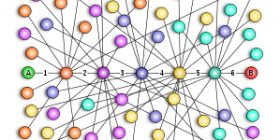Twenty years ago, as a music fan, you would hear a song you enjoyed on the radio, head to the record store to buy the album and wait until the band came to town to attend a concert. The music industry was based on a straightforward consumption model.
In this online day and age you can consume music on innumerable platforms, interact with artists and other fans, and discover or share your music with the click of a button. Last year alone, more than 3 billion fans played over 60 billion songs on various online music platforms.
The ability to track and catalog all of this activity has evolved only in the last few years and begs the question: does this social media activity actually lead to album or track sales? Which of the countless networks actually matter? Radio spins have long been considered the industry standard for predicting sales, and with good reason, but is that still the case? By combining radio and iTunes sales data for thousands of artists with social media data from all the major networks, from Facebook to YouTube, to Twitter and Last.fm, we found good reason for why the industry should pay attention to the rest of the numbers.
In our analysis we focused on measuring the impact of social media on iTunes digital sales, both album and track units, initially looking at same day correlations between social media metrics and sales across all artists. This first-pass overview of the data confirmed suspicions that social media numbers did indeed correlate to sales; certain metrics even more so than radio spins. A particularly interesting phenomenon we discovered here, is that there is a difference in the metrics that are relevant to track sales versus album sales.
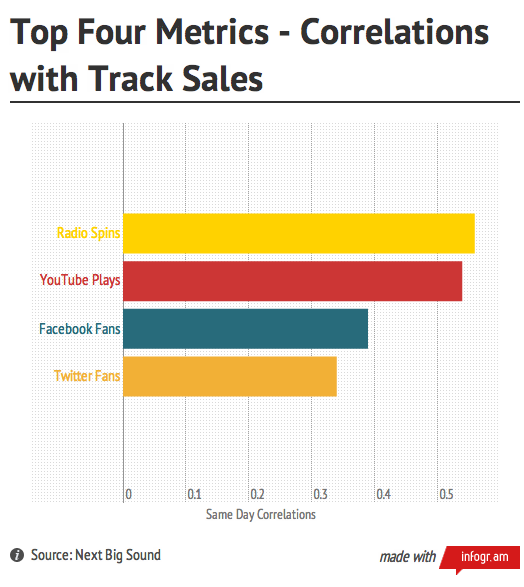
As expected, radio had a strong relationship to single sales. YouTube also had a strong showing, suggesting that consumers are looking for easy access to these singles in order to familiarize themselves with the songs. Because this is the case, strong visual content is key. In the case of album sales, the picture is somewhat different.
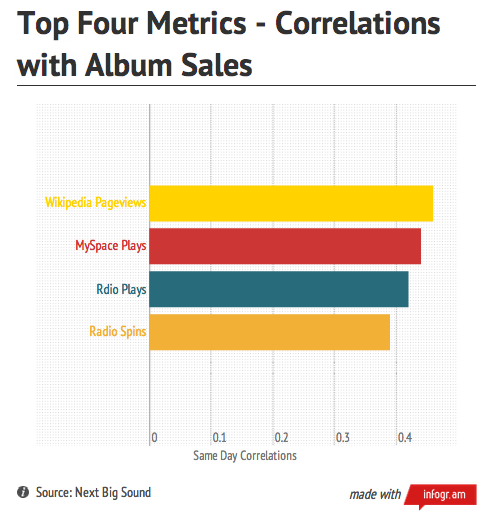
What is perhaps most surprising here is the high correlation between Wikipedia pageviews of an artist with album sales. But the explanation is most likely a fairly simple one, consumers, internet-savvy as they are, are now typing artist names into search engines in order to find out more about the artist. The question is whether these pageviews are preceding the purchase of an album or simply moving in tandem? The appearance of MySpace on this list can most likely be attributed to the three years worth of data we are examining, but it will be interesting to see whether the site rises in importance once again, following the relaunch in early 2013.
In order to see whether social media activity is in fact driving sales, we would have to dig a little deeper. This leads us to the second step, adding a time component by looking at correlations between social media numbers in the week leading up to an album release and the album’s first week sales. This is notoriously one of the hardest figures to predict in the music industry. For decades music fans perused record stores in search of the gripping sound that would drive a purchase, rendering the prediction of future album sales a guessing game based on the sales for previous records, a gamble compared to the time and money invested in a release. As such, increased accuracy here could potentially save the industry millions in misspent promotional dollars.
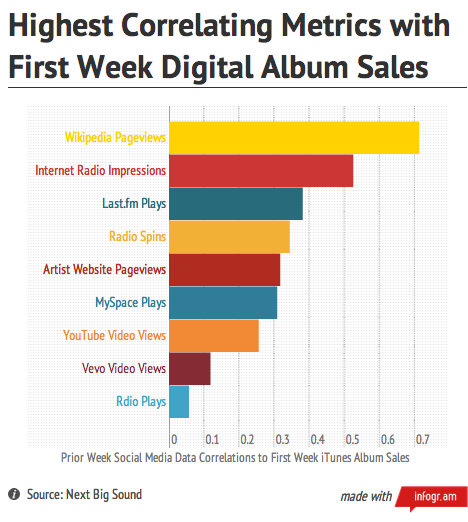
Once again, we see evidence of a strong relationship between Wikipedia and sales, underscoring our argument that consumers want more information about the artist whose album they are about to invest in, and emphasizing the importance of keeping an artist’s Wikipedia page up to date. What is more, Internet radio, sites such as Pandora, Rhapsody, and Sirius, also appear high on the list – fans are discovering music through more channels than traditional broadcast radio.
So far we have focused on basic correlation, and as the oft-repeated mantra goes, “correlation does not imply causation.” The final stage of analysis is to verify our findings by calculating the likelihood of a true causal relationship. The Granger causality test is commonly used in economics and neuroscience. This concept focuses on whether one set of data is useful in forecasting another. With this we are able to determine whether the inclusion of a particular social media metric in fact improves the predictability of future album and track sales.
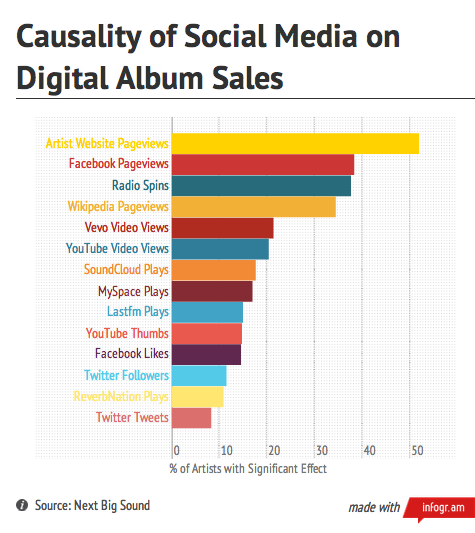
In the case of digital album sales, we found that for more than 50 percent of artists, taking into account the number of visits to their website helped more accurately determine what their first week album sales would be. Other leading indicators of future album sales are Facebook pageviews, traditional radio, and once again, Wikipedia pageviews.
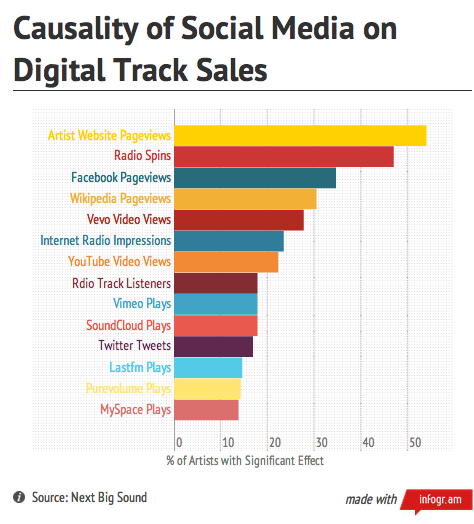
Also in the case of track sales, visits to an artist’s website are a critical piece of the puzzle, along with Facebook and Wikipedia. Broadcast radio rises in importance in comparison to album sales, as well as video streaming sites Vevo and YouTube. Both these sites give consumers easy, instant access to individual tracks they wish to familiarize themselves with.
Social media has a concrete and measurable impact on sales, certain metrics more so than others, and can serve as an aid to the industry when it comes to determining where to focus marketing efforts. People will hear a single on the radio or YouTube and buy it. But before they invest in a more costly album they want to find more about the artist via the artist’s website or Wikipedia. With the vast amount of information we now possess about the habits of listeners, we can harness the power of social media to not only drive sales, but also improve upon predictions of how an album will perform before it is even released.
Via Sidewinder.FM






